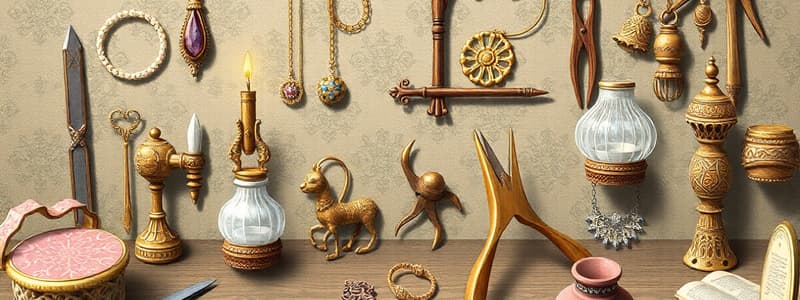Podcast
Questions and Answers
What type of pliers is specifically used to hold, shape, and manipulate findings in jewelry without scratching them?
What type of pliers is specifically used to hold, shape, and manipulate findings in jewelry without scratching them?
- Round-nose Plier
- Crimp Plier
- Jewelry-grade Pliers (correct)
- Needle-nose Plier
Which tool is best suited for rolling beads when mandrels are not available?
Which tool is best suited for rolling beads when mandrels are not available?
- Bamboo Skewers (correct)
- Beading Mat
- Needle-nose Plier
- Round-nose Plier
What are collapsible eye needles particularly useful for in jewelry making?
What are collapsible eye needles particularly useful for in jewelry making?
- Cutting fabric
- Applying adhesives
- Stringing beads with small holes (correct)
- Embellishing fabrics
Which material is considered best for making accessories due to predictability in results?
Which material is considered best for making accessories due to predictability in results?
What type of thread is specifically made from synthetic materials such as polyethylene or nylon for jewelry applications?
What type of thread is specifically made from synthetic materials such as polyethylene or nylon for jewelry applications?
Which tool is primarily used to prevent beads from rolling away on a work surface?
Which tool is primarily used to prevent beads from rolling away on a work surface?
What characteristic of specialty ribbons makes them particularly useful in fashion accessory creation?
What characteristic of specialty ribbons makes them particularly useful in fashion accessory creation?
Which of the following materials can be effectively used to create doughnut-shaped beads?
Which of the following materials can be effectively used to create doughnut-shaped beads?
What is the primary function of headpins in jewelry making?
What is the primary function of headpins in jewelry making?
Which gauging characteristic affects the thickness of wire used in jewelry making?
Which gauging characteristic affects the thickness of wire used in jewelry making?
What is the best way to select jump rings for a jewelry project?
What is the best way to select jump rings for a jewelry project?
Which description best fits eye pins in jewelry making?
Which description best fits eye pins in jewelry making?
What role does a Bracelet Sizer Planning Board serve in jewelry design?
What role does a Bracelet Sizer Planning Board serve in jewelry design?
Flashcards
Pliers
Pliers
Used to hold, shape, and manipulate findings in jewelry. Jewelry-grade pliers are best as they won't scratch metal findings.
Flush Wire Cutter
Flush Wire Cutter
Used to cut wires, headpins, and eye pins.
Mandrels
Mandrels
Metal rods used to create lamp work beads. Bamboo skewers can be a substitute.
Paintbrushes
Paintbrushes
Signup and view all the flashcards
Beading Mat
Beading Mat
Signup and view all the flashcards
Felting Needles
Felting Needles
Signup and view all the flashcards
Collapsible Eye Needle
Collapsible Eye Needle
Signup and view all the flashcards
Fabrics
Fabrics
Signup and view all the flashcards
Wire
Wire
Signup and view all the flashcards
Sequins
Sequins
Signup and view all the flashcards
Beads
Beads
Signup and view all the flashcards
Jump Rings
Jump Rings
Signup and view all the flashcards
Necklace Planning Board
Necklace Planning Board
Signup and view all the flashcards
Study Notes
Tools, Equipment, & Materials for Making Fashion Accessories
- Lesson Objectives:
- Identify materials, tools, and equipment used in fashion accessory making.
- Describe each material, tool, and piece of equipment used in fashion accessory making.
- Discuss the functions and uses of each material, tool, and piece of equipment.
- Demonstrate techniques and procedures in using the tools for fashion accessory making.
Lesson Outline
- Tools and Equipment for Making Fashion Accessories
- Materials in Making Fashion Accessories
Pliers
- Used to hold, shape, and manipulate jewelry findings.
- Some pliers are designed not to scratch metal findings.
- Types:
- Needle-nose Plier: Flat jaws, basic pliers for most jewelry techniques.
- Round-nose Plier: Round jaws that taper to a point, used for making loops.
- Crimp Plier: Special pliers for closing and creating a professional look for crimp beads.
Flush Wire Cutter
- Used to cut or trim wires, headpins, and eye pins.
Mandrels or Bamboo Skewers
- Used for rolling beads.
- Commonly made of metal, used to make lampwork beads.
- Can be purchased from glassworks supply stores or use bamboo skewers if mandrels are unavailable.
Paintbrushes
- Perfect for applying acrylic mediums, adhesives, and decorative elements to jewelry.
- A variety of small brushes is necessary for jewelry work.
Beading Mat
- Used to keep beads from rolling around on a work surface.
Awl
- A long metal tool that tapers to a point.
- Used for poking holes and holding tiny pieces in place during work.
Tapestry Needles
- Designed for use with thicker materials like embroidery floss or pearl cotton.
- Also suitable for ribbons and smaller cords.
Collapsible Eye Needle
- Ideal for stringing beads with very small holes.
- Flexible eye of the needle can squeeze flat through bead holes.
Felting Needles
- Not needles, but thin pieces of barbed metal.
- Used to push wool roving fibers into another piece of wool or fabric to felt them together.
Materials in Making Fashion Accessories
-
Fabrics:
- Suitable for making accessories when solid in color or have small-scale prints.
- Offers the most predictable results.
-
Ribbons:
- A narrow material with finished edges that do not fray.
- Many specialty ribbons are available for varied creations.
-
Beading Threads:
- Come in a variety of colors and are made of synthetic materials like polyethylene or nylon.
-
Sewing Machine Threads:
- Used for sewing machine projects.
-
Cords and Yarns:
- Offer a variety of uses in fabric jewelry.
- Available in many varieties in knitting and needlepoint stores.
-
Metal Washers:
- Used to create doughnut-shaped beads.
- Available in an assortment of sizes at hardware stores.
-
Buttons:
- Useful for creating bead cores.
-
Crimp Beads:
- Used to add clasps to the end of beading wire or to secure beads on the beading wire.
-
Flexible Beading Wire:
- Available in many diameters and finishes.
-
Wire:
- Can be bent into different shapes.
- Made from various metals and gauges; higher gauge numbers mean thinner wire.
-
Jump Rings:
- Used to connect jewelry elements like beads, charms, and chains.
- Come in assorted sizes; use the smallest jump ring for optimal results.
-
Headpins:
- Pieces of wire with a stopper at one end (plain or decorative).
- Come in varying lengths and metals.
-
Eye Pins:
- Pieces of wire with a loop at one end.
- Connect jewelry components.
-
Terminators:
- Used at a cord or chain end to cover knots and closures.
- Can be plain to avoid drawing attention or fancy as a design element.
-
Sequins:
- Come in a variety of colors, sizes, shapes, and finishes.
-
Beads:
- Decorative objects made of glass, plastic, or wood.
- Available in various shapes (e.g., European doughnut, Japanese tubular, cut-out).
- Common finishes include matte, opaque, transparent, translucent, iridescent, galvanized, metallic, and silver-lined.
-
Bracelet Sizer:
- Used to precisely measure bracelet size.
-
Necklace Planning Board:
- Used for assembling the materials needed to plan a bracelet or necklace design.
- Guides users to develop a detailed image of the final product before beginning.
Studying That Suits You
Use AI to generate personalized quizzes and flashcards to suit your learning preferences.
Related Documents
Description
This quiz covers the essential tools, equipment, and materials required for creating fashion accessories. It includes the identification, description, and function of various tools like pliers and wire cutters, as well as a demonstration of their use in jewelry-making techniques. Test your knowledge on the necessary equipment for fashion accessory crafting.





